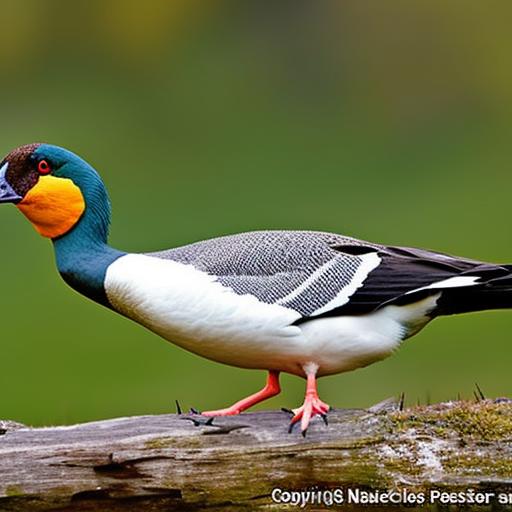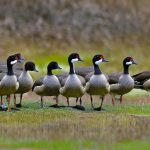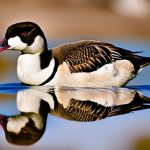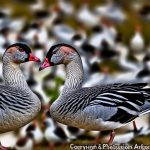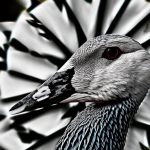Geese invading properties and causing damage is a common problem that many property owners face. These birds can be a nuisance, leaving behind droppings, damaging lawns, and even posing a threat to human safety. Fortunately, there are various methods that can be used to deter geese and prevent them from causing further damage.
One of the most effective ways to deter geese is by understanding their behavior and implementing strategies that exploit their habits and patterns. By doing so, property owners can create an environment that is less attractive to geese, making it more likely for them to move on to another location.
Key Takeaways
- Geese are social animals and tend to stay in groups.
- Physical barriers like fences and netting can prevent geese from accessing certain areas.
- Decoys can be effective in deterring geese, especially if they are moved around frequently.
- Motion-activated sprinklers can startle geese and make them uncomfortable.
- Goose repellent products can be applied to plants and other surfaces to discourage geese from landing or feeding.
Understanding the behavior of geese
Geese are attracted to certain areas for several reasons. One of the main reasons is the availability of food sources. Geese are herbivores and are particularly attracted to grassy areas where they can graze. They also prefer areas near bodies of water, such as ponds or lakes, where they can find both food and safety.
Geese are also social animals and tend to gather in large groups. They have a strong sense of community and will often return to the same location year after year if it meets their needs. This is why it is important to understand their habits and patterns in order to effectively deter them.
Implementing physical barriers to deter geese
One method of deterring geese is by implementing physical barriers. There are several types of physical barriers that can be used, including fences, netting, and hedges. Fences can be effective in keeping geese out of certain areas, but they need to be at least three feet high to prevent the birds from flying over them.
Netting can be used to cover areas where geese tend to gather, such as ponds or lawns. This prevents them from accessing these areas and can discourage them from returning. Hedges can also be effective in creating a physical barrier, as geese are less likely to land in areas with dense vegetation.
It is important to properly install and maintain these barriers to ensure their effectiveness. Fences should be securely anchored to the ground and checked regularly for any damage or gaps. Netting should be properly secured and checked for any tears or holes. Hedges should be trimmed regularly to maintain their density.
Using decoys to keep geese away
Another method of deterring geese is by using decoys. Decoys are objects that resemble geese and can be used to create the illusion of a populated area, which can deter geese from landing. There are different types of decoys that can be used, including stationary decoys and moving decoys.
Stationary decoys are typically made of plastic or foam and are placed in areas where geese tend to gather. These decoys create the appearance of a flock of geese and can discourage other geese from landing in the area. Moving decoys, on the other hand, are designed to mimic the movement of real geese. They can be powered by wind or electricity and can be effective in deterring geese.
It is important to properly use and maintain these decoys to ensure their effectiveness. Stationary decoys should be moved regularly to create the illusion of movement. Moving decoys should be checked regularly for any damage or malfunctions.
Installing motion-activated sprinklers
Motion-activated sprinklers are another effective method of deterring geese. These sprinklers are equipped with motion sensors that detect the presence of geese and activate a burst of water, scaring them away. The sudden burst of water surprises the geese and makes them associate the area with an unpleasant experience, discouraging them from returning.
One of the benefits of using motion-activated sprinklers is that they provide a non-harmful deterrent that does not harm the geese or the environment. They are also easy to install and can be adjusted to cover specific areas. Additionally, they can be set to operate at specific times, such as during the hours when geese are most active.
Applying goose repellent products
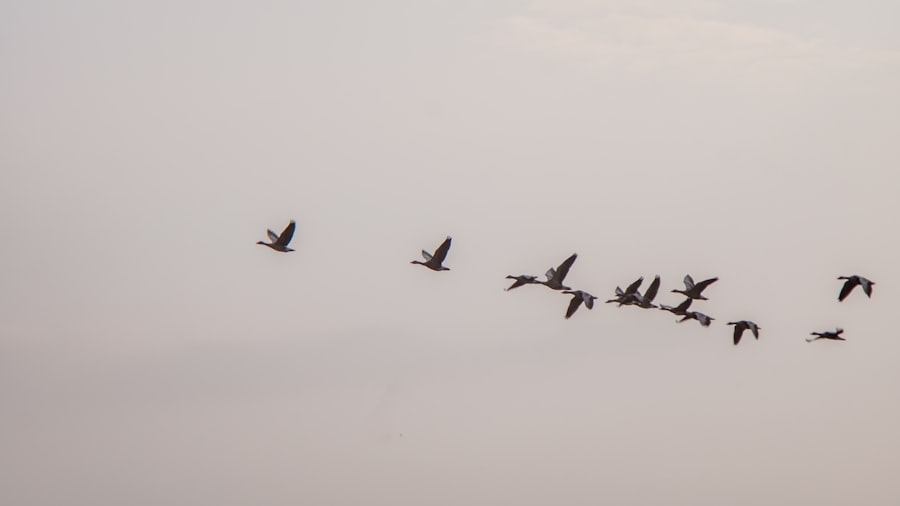
There are various goose repellent products available on the market that can be used to deter geese. These products typically contain ingredients that are unpleasant to geese, such as methyl anthranilate or capsaicin. They can be applied to areas where geese tend to gather, such as lawns or ponds, and create a deterrent effect.
It is important to properly apply and maintain these products to ensure their effectiveness. Goose repellent products should be applied according to the manufacturer’s instructions and reapplied regularly, especially after rain or heavy watering. It is also important to check for any damage or wear on the product and replace it if necessary.
Removing potential food sources
Geese are attracted to certain types of food, such as grass, grains, and aquatic plants. By removing these food sources from the property, property owners can make their property less attractive to geese. This can be done by regularly mowing the lawn, removing fallen fruits or seeds, and trimming vegetation near bodies of water.
It is also important to properly dispose of any food waste or scraps that may attract geese. This includes emptying outdoor trash cans regularly and securing compost bins or food storage areas.
Creating a noisy environment
Geese are sensitive to noise and can be deterred by creating a noisy environment on the property. There are various types of noise that can deter geese, including loud music, clapping, banging pots and pans together, or using noise-making devices such as air horns or whistles.
Creating a noisy environment can be done by playing loud music or using noise-making devices in areas where geese tend to gather. It is important to vary the noise and not use the same sound consistently, as geese can become accustomed to certain noises over time.
Encouraging natural predators
Geese have natural predators, such as foxes, coyotes, and certain species of birds. By encouraging these predators to visit the property, property owners can create a natural deterrent for geese. This can be done by providing suitable habitats for these predators, such as dense vegetation or nesting boxes.
It is important to research the specific predators that are native to the area and create habitats that meet their needs. It is also important to ensure that these predators do not pose a threat to human safety or other wildlife.
Modifying the landscape to make it less attractive to geese
Modifying the landscape can also be an effective way to make the property less attractive to geese. This can be done by removing or reducing areas of open grass and replacing them with alternative landscaping features, such as gravel or mulch. Geese are less likely to land in areas that do not provide suitable grazing opportunities.
It is also important to consider the placement of water features on the property. Geese are attracted to bodies of water, so it may be necessary to modify or relocate existing ponds or lakes to discourage geese from gathering.
Seeking professional help for long-term solutions
While there are various methods that can be used to deter geese, seeking professional help can provide long-term solutions. Professionals who specialize in wildlife management can assess the property and provide customized solutions based on the specific needs and challenges of the property.
When seeking professional help, it is important to find a reputable and experienced professional who has a proven track record in dealing with geese-related issues. They should be able to provide references and have a thorough understanding of local regulations and best practices.
In conclusion, there are various methods that can be used to deter geese and prevent them from causing damage to properties. Understanding the behavior of geese and implementing strategies that exploit their habits and patterns can be an effective way to deter them. Physical barriers, decoys, motion-activated sprinklers, goose repellent products, removing potential food sources, creating a noisy environment, encouraging natural predators, modifying the landscape, and seeking professional help are all methods that can be used to deter geese. By taking action and implementing these methods, property owners can protect their properties from geese and prevent further damage.
If you’re looking for more information on how to keep geese away, you might find this article on Poultry Wizard helpful. It discusses whether geese can eat chicken feed and provides insights into the best practices for feeding geese. Check it out here. For more poultry-related tips and advice, visit the Poultry Wizard website at https://poultrywizard.com. Additionally, if you’re interested in learning about the ideal flooring for a chicken coop, this article on their site provides valuable insights: https://poultrywizard.com/keeping-chickens/floor-of-chicken-coop/.
FAQs
What are some effective ways to keep geese away?
There are several effective ways to keep geese away, including using decoys, installing fencing, using repellents, and modifying the landscape.
What are some natural repellents that can be used to keep geese away?
Some natural repellents that can be used to keep geese away include grape concentrate, garlic, and hot pepper.
What are some non-lethal methods of keeping geese away?
Non-lethal methods of keeping geese away include using noise deterrents, visual deterrents, and habitat modification.
What are some visual deterrents that can be used to keep geese away?
Visual deterrents that can be used to keep geese away include reflective tape, scarecrows, and predator decoys.
What are some noise deterrents that can be used to keep geese away?
Noise deterrents that can be used to keep geese away include propane cannons, air horns, and electronic bird repellers.
What are some habitat modifications that can be made to keep geese away?
Habitat modifications that can be made to keep geese away include removing food sources, planting tall grasses, and installing barriers around bodies of water.
Meet Walter, the feathered-friend fanatic of Florida! Nestled in the sunshine state, Walter struts through life with his feathered companions, clucking his way to happiness. With a coop that’s fancier than a five-star hotel, he’s the Don Juan of the chicken world. When he’s not teaching his hens to do the cha-cha, you’ll find him in a heated debate with his prized rooster, Sir Clucks-a-Lot. Walter’s poultry passion is no yolk; he’s the sunny-side-up guy you never knew you needed in your flock of friends!

